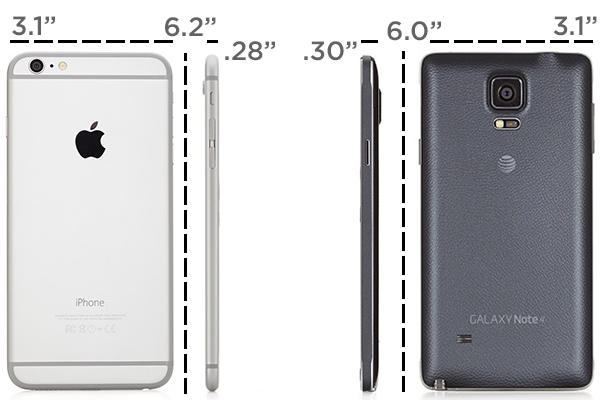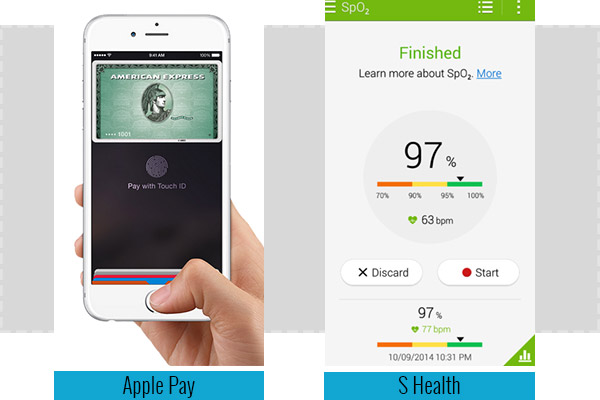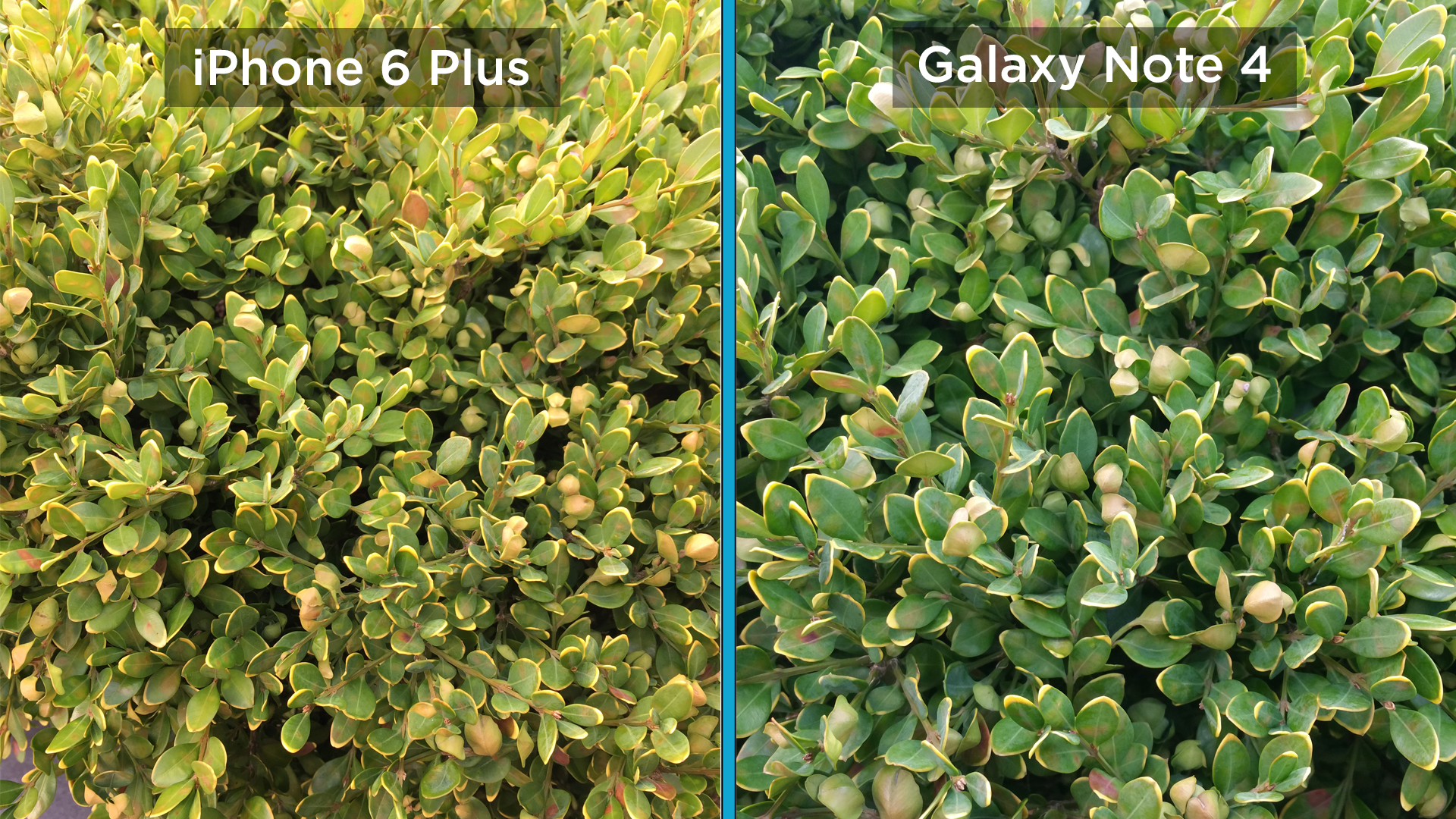iPhone 6 Plus vs Galaxy Note 4: Phablet Face-Off
Almost every smartphone maker has now hopped on the phablet bandwagon, pushing screen sizes up and over the 5-inch barrier. But the two biggest names in this arena are Apple and Samsung. With the 5.7-inch Galaxy Note 4, Samsung continues to refine its fo


Almost every smartphone maker has now hopped on the phablet bandwagon, pushing screen sizes up and over the 5-inch barrier. But the two biggest names in this arena are Apple and Samsung.
With the 5.7-inch Galaxy Note 4, Samsung continues to refine its fourth generation of super-sized phones. The company started the screen-size arms race back in 2011 but has now added a quad HD screen along with improved pen functionality. Meanwhile, the 5.5-inch iPhone 6 Plus marks the first time Apple has entered this fast-growing category. It offers some key advantages over the regular iPhone 6, including optical image stabilization for the camera and a dual-pane mode for many apps.
So which phablet is tops, the refined reigning champ or the promising newcomer? We put these two devices through 10 rounds of combat to declare a winner.
Design
After taking a look at the iPhone 6 Plus' gorgeous aluminum body and smooth rounded edges, you might be quick to award best design to Apple. But not so fast. Without even touching on #Bendgate, the Note 4 features clever design choices that propel it to a win based on its own merits.

While I don't particularly care for the faux-leather finish on the Note's plastic rear cover, I do like the ability to remove it and swap out the battery, SIM card and microSD card at will. Samsung also adds sleek aluminum edges (first seen on the Galaxy Alpha), and manages to wedge in a hidden slot for the S Pen stylus. Comparatively, the iPhone 6 Plus is really just another pretty face. The sleek body sacrifices features for thickness, and after seeing how it reacted to a couple of minor tumbles, it feels less durable too.
MORE: Apple iPhone 6 Plus Review | Samsung Galaxy Note 4 Review
As for size, at 6.0 x 3.1 x 0.33 inches, the Galaxy Note 4 is actually shorter than the 6 Plus despite its larger screen, and still less than five-hundredths of an inch thicker and wider than the 6.22 x 3.06 x 0.28-inch Apple device. While the Note 4 (6.21 ounces) does weigh a tenth of an ounce more than the iPhone 6 Plus (6.07 ounces), overall dimensions are so close that it doesn't sway victory away from the Samsung.
Winner: Galaxy Note 4. It's not as beautiful, but it's more functional.
Display
For phablets, the screen is everything, and while both Apple and Samsung feature beautiful premium displays, they are not without their faults. The Galaxy Note 4's AMOLED display has deep gorgeous blacks that are unmatched by the iPhone 6 Plus. The downside is a slight bluish tint to everything you see.
The Note 4's Quad-HD 2560 x 1440 resolution is nice, but the visible difference between that and the iPhone 6 Plus' 1920 x 1080 resolution isn't noticeable.

When set to auto brightness, both phones amp up their displays for better outdoor viewing, with the Note 4 reaching 770 lux, and the iPhone 6 Plus measuring 685 lux. Unfortunately for the Note 4, colors start to become blown out, making pictures and videos look less detailed compared with the iPhone 6 Plus.
The Note 4's screen can display a wide range of colors, recreating 163 percent of the sRGB spectrum. The iPhone 6 Plus is more limited, but still performs well, recreating 95.3 percent. In terms of color accuracy, the iPhone performs better than the Note 4 with its Delta-E of 1.9 (closer to zero is best), compared to the Samsung's Delta-E of 4.2, which is just slightly better than the smartphone average of 4.6.
MORE: Readers' Choice: Vote for the Year's Best Smartphones
So despite having slightly weaker blacks, I prefer the iPhone 6 Plus' display because its display looks better outdoors and isn't hampered by the slight blue tint seen on the Galaxy Note 4.
Winner: iPhone 6 Plus. Its more color-accurate screen gives it a slight edge.
Audio
Truthfully, Apple and Samsung’s phablets fail my basic smartphone audio assessment, as they both lack front-facing speakers, but I'm not here to give a tie. On the Tom's Guide audio test (measuring the loudness of a tone from 13 inches), the iPhone 6 Plus (78 decibels) produced less volume than the Galaxy Note 4 (81 dB). Like volume, audio quality is similarly just a notch better on the Note 4 as opposed to the 6 Plus.
When I listened to Air's "Alone in Kyoto," the iPhone struggled with the shimmery notes in the song's intro and on Chris Isaak's "Baby Did a Bad Bad Thing," the Note 4 did a better job reproducing clear guitar notes with less distortion.
Winner: Galaxy Note 4, but both could be better.
OS and Interface
This is a battle between Android and iOS. Apple has always produced a very clean and easy-to-use mobile OS. Flipping between pages on the home screen is smooth, and I really like the speed at which Spotlight search can find almost anything I want. But at the end of the day, I still feel like iOS is holding me back. It’s more of a pain to customize the home screen, and Samsung offers easier access to more quick settings, which you can also customize.

In addition, Apple's lack of Multi Window functionality feels like a big omission. Unlike the Galaxy Note 4, you can't run two different apps side by side. The Note 4 also lets you drag and drop content from some Multi Window-friendly apps to another.
Even with iOS 8's support for third-party widgets via Notification Center and additional keyboards, iOS continues to play catch up to the wide variety of tools that already exist on Android and Samsung's TouchWiz.
Winner: Galaxy Note 4. Flexibility is king.
Special Features
This is one category where the Galaxy Note 4 crushes the iPhone 6 Plus. The Samsung features a heart rate sensor, S Pen with handwriting support, fast charging (50 percent in 30 minutes) and real NFC. What I mean by that is that NFC isn’t just used for mobile payments; you can tap to pair devices. The only thing the 6 Plus really has going for it that's truly unique is Apple Pay.

The iPhone experience gets better when combined with other Apple products using Handoffs in OSX Yosemite, but that is of little consequence for people who aren't completely locked in to the Apple ecosystem.
Winner: Galaxy Note 4. Real NFC, a heart rate sensor and S Pen beat out Apple Pay.
Performance
It's difficult to compare the capabilities of devices running different OSes, but we used some third-party benchmarks and real-world comparisons to make choosing between the two easier.
The iPhone 6 Plus features an Apple A8 processor with a 1.4-GHz dual-core ARM based CPU and 1GB of RAM, while the Note 4 has a quad-core 2.7-GHz Qualcomm Snapdragon processor and 3GB of RAM.

On Geekbench 3, which tests overall system performance, the Galaxy Note 4 finished ahead with a score of 3,124, compared with the iPhone 6 Plus' 2,903.
We saw mixed results in graphics tests. In 3DMark Ice Storm Unlimited, the Note 4 bested the iPhone 6 Plus, scoring 20,126 to 16,965. However, using WebGL cubes, which renders 150,000 rotating cubes, the iPhone managed a strong 15 fps, more than twice the Note 4's score of 7 fps. The difference in the latter number could be the result of the Note 4 having to push 70 percent more pixels with its Quad HD display.

To control for the different display resolutions, we ran the GFXBench Manhattan 1080p off-screen test, which renders a graphics-heavy 1920 x 1080 sequence. The iPhone 6 Plus' 19 frames per second finished ahead of the Note 4's 13 fps. The GFXBench T-Rex 1080p off-screen test saw similar results, with the iPhone 6 Plus' mark of 45.2 fps beating out the Note 4's score of 27.4 fps.
When using Futuremark's Peacekeeper test, which measures browser performance, the iPhone 6 Plus running Safari scored 2,592. That's more than double the Note 4's mark of 1,069. The SunSpider browser benchmark, which gauges Javascript performance, mirrored the results from Peacekeeper. The iPhone 6 Plus on Safari completed the test in 351 milliseconds (faster is better), ahead of the Note 4's score of 1186 ms in Chrome and 539 ms using the default Samsung browser.
MORE: iPhone 6 Benchmarks: Here's How Good It Really Is
In real-world performance, the Note 4 can sometimes feel more sluggish than the silky smooth iPhone 6 Plus, but some of that is due to Samsung's TouchWiz skin, parts of which can be disabled to get back a little speed (such as S Voice and animations). Booting straight into the camera from the lock screen was faster on the 6 Plus by about a quarter second, but opening apps like YouTube or Spotify are equally fast.
Winner: Draw. While the Note 4 performs better on CPU benchmarks, the iPhone 6 Plus offers better results in browser and some graphics tests and certain real-world apps.
Camera
This is one of the most hotly contested categories. In bright-light scenarios, Apple's 8-megapixel camera shines.

In a photo of a shrub on our rooftop lounge, the iPhone accurately captured the bush's yellow-green leaves. The 16-MP Galaxy Note 4 captured a more pleasant, although incorrect, deeper green.
MORE: Best Smartphone Cameras
For low-light shots, Apple has made a point to keep its camera at 8 megapixels, and to make each larger, in order to achieve better images. Based on our testing, the iPhone 6 delivers superior low-light performance compared to the Note 4.

When comparing an indoor shot taken by both phones at a local bar, not only was the iPhone 6 Plus' photo more accurate and realistic, it did a better job of capturing detail. The Galaxy Note 4's picture is brighter, but it suffers from some blown-out areas, as seen on the backlit bottles behind the bar.

Both cameras also feature digital zooms, and while full magnification images are a little too pixelated for my taste, photos with the Note 4 have a little more detail and sharpness due to its higher megapixel camera.

Comparisons between the two front-facing cameras are mostly a wash, but with 3-MP for the Note 4 versus 1.2-MP iPhone 6 Plus, Samsung pulls out to the tiniest of leads with its shooter having just a bit more detail than the iPhone's FaceTime camera, and a wider angle of view with its 16:9 picture ratio.
Winner: iPhone 6 Plus and its top-notch low-light performance.
Apps
Between Samsung's S Health and Apple's Health app, S Health seems more useful, as it's more than just a dashboard. You can track your diet, get workout advice and collect data from your wearable devices, all in one place.
MORE: Best Android Apps 2014
Other Samsung apps, such as Samsung Wallet and AllTogether, feel superfluous or useful in only niche situations. But there are some sleek and useful options, such as Milk for streaming music, S Note and SketchBook for taking full advantage of the S Pen, and Smart Remote for controlling your TV.
The iPhone 6 Plus benefits from Apple's iLife and iWork apps such as Music, iMovie and Garageband, providing you with some of the best free apps for staying organized and enjoying content and creating new works, all on your phone.
MORE: Hottest iOS 8 Apps
And let's not forget that iOS still enjoys an advantage in terms of exclusive apps and getting hot apps first, such as Epic Zen Garden, Facebook Paper and the Dark Sky weather app. Android versions on Google Play usually show up later.

Lastly, iPhone 6 Plus owners don't need to deal with carrier bloatware. The AT&T version of the Note 4, example, comes pre-loaded with all sorts of stuff that you don't need.
Winner: iPhone 6 Plus, and its suite of iOS apps and slightly larger app store.
Battery Life
On paper, the Galaxy Note 4's 3220 mAh battery should trounce the 2915 mAh battery of the iPhone 6 Plus. But on the Tom's Guide battery test (continuous Web surfing over 4G at 150 nits of brightness), the iPhone 6 Plus' battery lasted 10 hours flat. That's 1 hour and 10 minutes longer than the Note 4's time of 8:47. However, in real-world use, that difference was much less pronounced.

The Galaxy Note 4 fared better during a more mixed-usage scenario. During a 24-hour period with both phones set to 100 percent brightness, we streamed music on Spotify for 2 hours and watched Vice's 52-minute documentary Surviving Alone in Alaska on YouTube at 1080p. The Samsung finished with 37 percent juice left versus 31 percent for the iPhone 6 Plus.
Winner: iPhone 6 Plus, but it's closer than it looks at first glance.
Value
This one is a no-brainer: The Samsung Note 4 is a much better value compared with the iPhone 6 Plus. Smartphones with just 16 GB of storage continue to be one of the biggest tech rip-offs, so I’m glad that the Galaxy Note 4 comes with 32GB standard. The same $200 gets you just a 16GB iPhone 6 Plus, leaving you much less room for media, games and apps.
There are 64 GB and 128 GB options for the 6 Plus, but they will run you an additional $100 or $200. respectively. The Note 4 has only one size, but it comes with a microSD Card reader that can handle an additional 128 GB of storage. With 128 GB microSD cards running as low as $60 dollars, you can buy a Galaxy Note 4 and a 128 GB card for less than the price of a 64 GB iPhone 6 Plus. (Just keep in mind that you can't store all of a given app on a card; some of it will live on internal memory.) And that's before you talk about features like the removable battery and S Pen.
Winner: Galaxy Note 4 by a mile. It offers more built-in storage for less money.
Overall Winner: Samsung Galaxy Note 4.
The competition was close, but overall the Galaxy Note 4 is the phablet to get.

Features such as the S Pen, a microSD card slot for expansion and Multi Window mode add more value, propelling the Note 4 ahead of the iPhone 6 Plus.

The iPhone 6 Plus has a lot of things to recommend it, including its more color-accurate screen, gorgeous aluminum body and easy-to-use OS. The 6 Plus also lasts longer on a charge.
However, Apple simply doesn't have the same kind of experience as Samsung has making phablets, and the Galaxy Note 4 is proof.
- Best Smartphones Available Now
- Galaxy S5 vs. Moto X: Smartphone Face-Off
- LG G3 vs. Galaxy S5: Smartphone Camera Face-Off
Follow @SamRutherford on Twitter and Google+, and @Tom’s Guide on Facebook and Google+
Sign up to get the BEST of Tom's Guide direct to your inbox.
Get instant access to breaking news, the hottest reviews, great deals and helpful tips.
Sam is a Senior Writer at Engadget and previously worked at Gizmodo as a Senior Reporter. Before that, he worked at Tom's Guide and Laptop Mag as a Staff Writer and Senior Product Review Analyst, overseeing benchmarks and testing for countless product reviews. He was also an archery instructor and a penguin trainer too (really).
-
TNel I'm really surprised you choose the iPhone's bar picture to be better. If I was just looking at the two and decided which is better I would have said the Note's picture was much better. I also disagree with your selfie, the iPhone had a much more accurate color tones, on the Note the person is very washed out.Reply -
Matthew Langley If you switch the Note 4 to "Basic" screen mode you get a more color accurate screen than the iPhone 6 plus. This is (partly) why nearly every other comparison on the internet gives the edge to the Note 4 screen.Reply -
sebby491 Camera is a Draw everything else is won by Note 4 easily. Battery Life is much better on Note 4, Note 4 has best screen of any phone on the market, annihilates the 6plus. Apps are much better optimised and more are available on Note 4. Based on the review i would have thought this apple biased site would have picked the 6plus, I guess in the end common sense prevailed and they chose the vastly superior note 4.Reply -
Bosco Butterman YOu forgot to mention the incredible RISK of using Android. So many hacker infected apps on the Marketplace - the chance of downloading something really harmful. The number of Android exploits grows every day, whereas we have yet to see an active exploit for IoS. Some might not find this a big issue, but it is if you have money in a bank and a good job making that money. I realize many of the people viewing this site are children in school who do not pay for anything, but it is important to remind your viewers who DO generate income that the total lack of security on Android is a HUGE show stopper.Reply -
The Enlightener Bosco Butter,Reply
The android market place (The Play Store) is no more at risk than the apple app store. Every app in the play store is scanned and verified before being able to be downloaded. What causes viruses for android is when the "allow 3rd party apps to be installed" check box is enable, that problems can occur. You see android gives you the option to utilize apps,services, etc. outside the store. You can do so, but at at your own risk. It's actually incredibly hard to get a virus on a phone, but more often than not when it does occur it's user error. That is why the simplistic, locked in, user friendly iphone is the way to go if you don't have much understanding of modern technology. Don;t get my wrong it's not a bad device, but you can get the same power, with more features, for less money on a PREMIUM android. I emphasise premium because every android is different. That;s because there are several manufacturers and hundreds of models. Don't believe the hype about viruses on smartphones, people need to to be proactive not reactive. -
The Enlightener Sam Rutherford,Reply
I agree with a majority of what you stated. I do however have one thing in the comparison I disagree with, the battery life. First let me start by saying that all androids come with bloatware. Once removed the performance and battery life noticeably increase. That includes your the cellular providers un-installable apps... WIth my Note 4, I get on "average use" (videos, research, games, music, checking the time, etc.) 36-42 hrs of use before it gets to the 1% where you just have to charge it. I could always enable the general power saver and gain an additional 2-3 hrs. Also if I were to enable the ultra power saver mode I could get up to 19.5 days of "basic use". Lastly If my battery starts to degrade I can always swap it out for another. With all that said, I think the battery portion of the mash up should go to the Note 4. -
Tech87 ReplyYOu forgot to mention the incredible RISK of using Android. So many hacker infected apps on the Marketplace - the chance of downloading something really harmful. The number of Android exploits grows every day, whereas we have yet to see an active exploit for IoS. Some might not find this a big issue, but it is if you have money in a bank and a good job making that money. I realize many of the people viewing this site are children in school who do not pay for anything, but it is important to remind your viewers who DO generate income that the total lack of security on Android is a HUGE show stopper.
